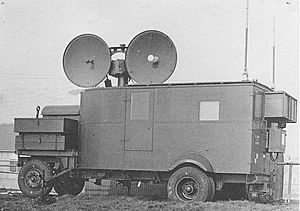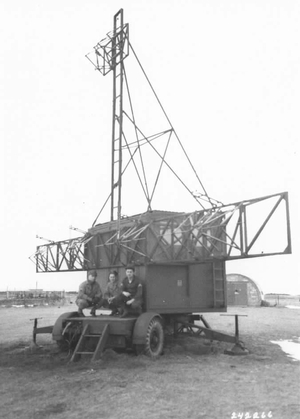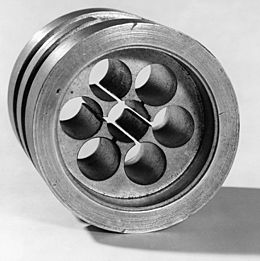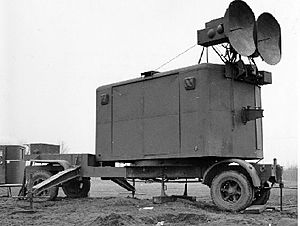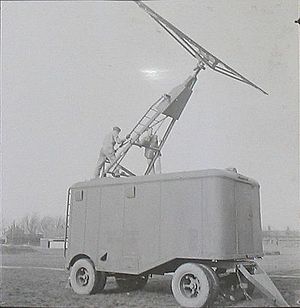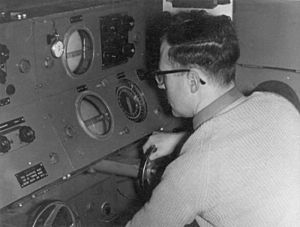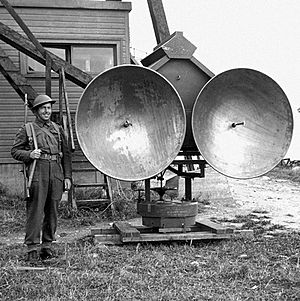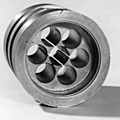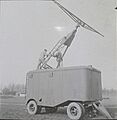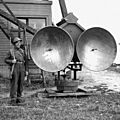GL Mk. III radar facts for kids
The Radar, Gun Laying, Mark III, or GL Mk. III for short, was a special radar system. The British Army used it to guide their anti-aircraft artillery (AA) guns. These guns shot down enemy planes. The GL Mk. III wasn't just one radar. It was a family of designs that kept getting better during and after World War II.
These radars were renamed in late 1942 to Radar, AA, No. 3. They often worked with another radar called the AA No. 4. This second radar helped spot planes from far away.
Development of the Mk. III started in 1940. This was after a new invention called the cavity magnetron came out. The magnetron made radar systems much smaller and more accurate. This was because they could use tiny radio waves called microwaves.
The magnetron was also shown to Canada and the US in 1940. Soon after, Canada started making its own GL radar. These were called GL Mk. III(C) (for Canadian). They arrived in the UK in November 1942. British-made versions, called GL Mk. III(B) (for British), came out in December.
Many of these radars were made. About 667 Canadian models and 876 British models were produced. Some were even sent to the Soviet Union. Later, a better US radar, the SCR-584, arrived in 1944. This meant the Mk. III units were used for other jobs. These included spotting artillery, watching coastlines, and tracking weather balloons. Some modified units were used until the late 1950s.
Contents
How Radar Guns Helped in War
Early Radar Systems for Guns
The British Army started serious research into radar in 1937. They learned about new radar ideas from the Air Ministry. The Army needed a way to find the exact distance to enemy planes. Before radar, they used optical tools, which were slow and often wrong. Radar could make this task much better.
The first system they built was the GL Mk. I radar. It used separate antennas to send and receive signals. These antennas had to move together to follow a target. The Mk. I could find the distance accurately. This information was sent to special computers. These computers helped aim the guns.
The Mk. I radar made a big difference. Before it, soldiers had to fire about 41,000 shells to shoot down one plane. With the Mk. I and better training, this dropped to 18,500 shells per plane by late 1940.
Later, the GL/EF system came out in early 1941. It helped even more, reducing shells per plane to 4,100. The Mk. II radar, which arrived in 1942, was even more accurate. It brought the number down to just 2,750 shells per plane. This made anti-aircraft guns much more effective.
The Magic of Microwaves
Older GL radar systems were very big and hard to move. This was because of the radio waves they used. These waves were several meters long. Antennas for these waves had to be roughly the same size. This meant antennas were often several meters long too.
Scientists wanted to use much shorter radio waves. This would help them find smaller objects, like U-boat periscopes. Also, the Air Ministry wanted smaller antennas for planes. They needed antennas small enough to fit in the nose of a twin-engine aircraft.
In November 1939, a meeting happened at the General Electric Company's (GEC) research center. They discussed making a radar system that used 10 cm waves (microwaves). This led to new research.
The Amazing Magnetron Invention
At Birmingham University, scientists were trying to improve an older device called the klystron. It made microwaves, but not very strongly. Two scientists, John Randall and Harry Boot, tried a new idea. They put many small cavities in a circle. Electrons were bent into a circular path using a strong magnet.
This new device was called the cavity magnetron. Their very first magnetron made 400 watts of power. Within a week, it made over 1 kilowatt! In just a few months, GEC was making models that produced 10 kilowatts. This invention changed radar development completely. It allowed for much more powerful and smaller radar systems.
The Army realized that these new microwave systems could give them better accuracy and smaller antennas. In August 1940, they asked for a new GL radar. It needed to combine an early warning system with a super-accurate microwave tracking system.
Building the GL Mk. III Radar
The Canadian GL Mk. III(C) Design
The Canadian design was called the Accurate Position Finder, or APF. At first, it was hard to switch microwave signals between antennas. So, the system needed separate antennas for sending and receiving. These antennas were about a meter wide. This was still much smaller than the old Mk. II antennas.
The whole electronics cabin of the Mk. III(C) had to turn to point the antennas. This made the trailer very complex. It also made the trailers fragile, causing problems for users.
A key difference in the Mk. III(C) was its display. Older radars used three screens (CRTs). The Mk. III(C) used mechanical pointers instead of screens for aiming. These pointers showed the direction to turn the cabin.
Canada also developed a second radar called the Zone Position Indicator (ZPI). This was an early warning radar. It helped find targets from far away. The ZPI would tell the APF where to look for planes.
The Canadian team finished their GL system design in June 1941. A full demonstration happened on June 27. US officials were very impressed. They said that what Canada did in nine months, their own companies would have taken two years to do.
Making the Canadian GL Mk. III(C) Units
Production of the Canadian units faced some challenges. A company called Research Enterprises Limited (REL) was set up to make military equipment. They were good at making optical gear, but struggled with electronics.
The first order for 40 GL sets was placed in January 1941. But REL had trouble delivering them. The first one wasn't ready until July 1942. More orders came from Canada, the UK, and other countries.
When the first units arrived in the UK in November 1942, they were unreliable. There were arguments between the designers and the factory. It turned out that the factory was focusing on making many units quickly, not on making them well. This meant they weren't properly tested.
Despite these problems, REL delivered 314 sets by the end of 1942. These quickly replaced older Mk. II sets in the UK. The Canadian Mk. III(C) units were important for defending London in early 1944. Some were even used to find German U-boats in the Saint Lawrence River.
By 1943, the need for Mk. III units decreased. This was because the better US SCR-584 radars were coming. The UK canceled its order in January 1944. In total, 667 Mk. III(C)s were made. About half went to Europe as mobile units, and half stayed in the UK.
Making the British GL Mk. III(B) Units
After the first test magnetron radar in April 1941, British Thomson-Houston (BTH) kept working on their Mk. III design. They introduced a Model B in July 1941. This led to an order for 28 handmade prototypes. The first production models arrived in December 1942.
The British Mk. III(B) design was better than the Canadian one. Its antennas were mounted on a tall metal pole called the rotor. This pole went through the roof of the trailer. Instead of turning the whole cabin, only the antennas on top of the pole rotated. This made the trailer much simpler and easier to use.
The Mk. III(B) also used fewer electronic tubes (valves). It went from 120 valves to just 60. This made it smaller, easier to move, and about half the cost. A small detail: the British versions had fabric covers over their antennas. This made them look like two flat disks, which helped tell them apart from the Canadian ones.
There were delays in production due to a shortage of electronic valves. It wasn't until late 1943 that full production started. By April 1945, 876 units had been delivered. Some of these included IFF (friend or foe identification) systems. These had two large antennas on the roof.
Soldiers noticed that the Mk. III(B) could even detect mortar shells from about 5,000 yards away. By tracking the shell's path, they could figure out where it was fired from.
GL Mk. III(B) Upgrades
The Mk. III(B) was upgraded several times. These later versions were known as the AA No. 3 Mk. 2.
- The Mk. 2/1 version added automatic tracking. This meant the radar could "lock on" to a target and follow it without constant manual control.
- The /2 could be used for anti-aircraft defense or for watching the coast.
- The /3 and /5 also had automatic tracking, but with slightly different designs.
- The AA No. 3 Mk. 2(F) was used by the army to find where enemy mortars were firing from.
The AA No. 3 Mk. 2/4 was the most used version of the original Mk. III design. It had extra parts that let it track targets much farther away. This version was used to measure winds high in the sky. It did this by tracking weather balloons with special radar reflectors. These units were used until the late 1950s.
Other GL Radars
While the Mk. III was being developed, the Army also worked on a smaller radar called "Baby Maggie." It was designed to be lightweight and easy to move, especially for landings on beaches. It could find targets up to 20,000 yards away. However, it had mechanical problems and was not very successful in battle.
Later, a new model called the AA No.3 Mk. 4, or "Glaxo," was developed in 1944. Only a few were made. Even more development led to the AA No. 3 Mk. 7. This was a very successful design. It became the UK's main gun-laying radar until the large anti-aircraft guns were removed from service in the late 1950s.
How the GL Mk. III Worked
This description is mostly about the British Mk. III(B) model. The Canadian Mk. III(C) was similar, but had some differences in its trailer and cabin.
Setting Up the Radar
The Mk. III was built on a large, four-wheel trailer. The cabin was made by a company that built railway carriages. To get it ready, the trailer was parked on flat ground and leveled using special jacks. Then, the radar dishes were raised, and the generator was started. It took about 20 minutes to set up and 3 minutes for the electronics to warm up.
The whole system, including the trailer, weighed over 9,000 kilograms (about 9 tons). It was about 4.2 meters (14 feet) tall when the antennas were up.
Inside the Radar
A motor powered the electronics and spun the receiver antenna at 440 rotations per minute. The radar's transmitter used a single magnetron. It sent out a short burst of radio waves (a pulse) 440 times per second. Later versions of the magnetron were very powerful, up to 350,000 watts.
The receiver had special parts that processed the incoming radar signals. These signals were then sent to screens (CRTs) where operators could see them.
Using the Radar
The Mk. III usually worked with another radar that could scan a full 360 degrees. Operators of this second radar would tell the Mk. III operators where to look for planes. The Mk. III operators would then turn their antenna to that direction and move it up or down to find the target.
Once a target was found, the operators would continuously adjust their controls to track it smoothly. The radar measured the distance, height, and direction of the plane. This information was then sent to special gun computers. These computers, called predictors, helped aim the anti-aircraft guns.
Identifying Friends or Foes (IFF)
By 1943, many British planes had an IFF Mk. III system. This system had a special radio that would listen for a signal from the radar. If it heard the signal, it would send out its own short signal back.
The GL Mk. III could have an interrogator to work with IFF. When the radar operator pressed a button, the interrogator would send out signals from a large antenna. If a friendly plane's IFF responded, a special mark would appear on the radar screen. This mark would be right behind the plane's blip. This helped operators easily tell if an aircraft was friendly or an enemy.
Using Radar for Weather
The Mk. III's longest use was for tracking weather balloons. This helped meteorologists measure winds high in the sky. They would launch balloons with special radar reflectors. The radar would then track them for a long time.
Since balloons often flew very far, these radars had a "Range Extender." This allowed them to track balloons up to 92,000 yards away. These units were known as AA No. 3 Mk. 2/4. They were widely used into the late 1950s for weather forecasting.
Images for kids


